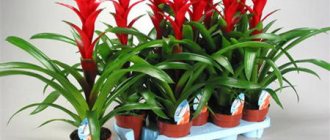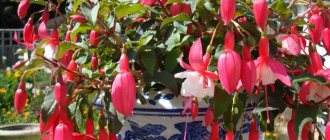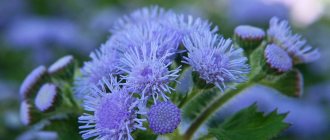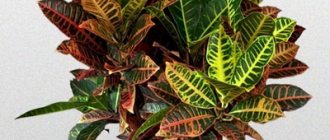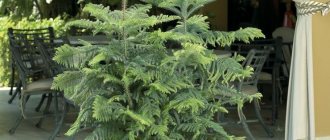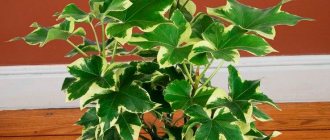Lovers of indoor plants are often attracted to unusual flower specimens. Aspidistra is often found in home flower collections. In past years, it was mistakenly classified as a member of the lily family. Since 2009, according to the updated classification system, Aspidistra has entered the Asparagus family. Aspidistra makes it easy to care for at home.
The hot forests of southern China and Japan are the natural habitats of this plant. The flower came to Europe in 1822, when it was discovered in China and brought to English flower growers.
The name of this plant contains a Latin word that translates as snake. “Indicator of snakes” is the literal translation. In nature, snakes can often be found in places where this plant grows. Perhaps Aspidistra received this name because of the grayish curved shoot that the adult plant produces. He resembles a snake. There are several unofficial names for this plant: “Friendly family”, “Cast iron flower”.
Features of the plant
A distinctive feature of the unpretentious “cast iron flower” is the absence of a stem. From the rhizome, half hidden by the ground, glossy elliptical leaves immediately grow.
Accustomed to living in cool, dense forests and indoor conditions, the “friendly family” does not have any special care requirements. So you will feel equally comfortable in rooms facing north, in poorly lit corridors and even in offices with artificial lighting. At the same time, it is capable of perfectly purifying the surrounding atmosphere from harmful impurities, including benzene and formaldehyde.
Achimenes - a flower with a variety of shapes and shades
The color range of this plant is truly diverse. Currently, almost the entire color range is represented among the Achimenes varieties: red, white, blue-violet, blue, yellow and all colors in between! The shape of an individual flower is also varied - simple and double, large and small in size, with different petal edges and structure relief. The bush itself as a whole can be either upright or hanging; cascading forms are also common.
“Mix” of hybrid varieties of Achimenes. In fact, there are many more varieties, choose to suit every taste and color!
Home care
In principle, aspidistra is very unpretentious. It does not put forward any special requirements for watering, lighting, and is not afraid of temperature changes. So even a novice gardener can cope with caring for her.
Location and lighting
Unlike most green plantings, aspidistra does not require bright lighting. On the contrary, the plant may wither due to excess sunlight. So in the summer, place a pot with a “cast iron flower” on northern window sills. But even in this case, shade the flowerpot on clear days. It’s better to place the pots on the wall away from the window. Just don’t put variegated varieties too far away, because if there is not enough light, the leaves may become monochromatic. In autumn and winter, you can move the flowerpot to the western or eastern window sills.
Temperature
The “snake pointer” does not tolerate heat well. It is advisable that in the warm season the air temperature should not be higher than +25°C. And preferably around 20 degrees. When the cold comes, you can lower the air to +15°C. Even +10 degrees will not harm the plant. In cool weather, the leaves will develop even more actively. Sudden changes in day and night temperatures are not scary for the green ward. He is also not afraid of drafts.
Watering
On summer days, the aspidistra needs to be watered approximately once a week. Just make sure that the earthen ball is not too flooded. After all, for a flower, an excess of moisture is much worse than a lack. Try to water until the substrate is two-thirds dry. In winter, when the pet is at rest, 1-2 waterings per month will be enough. Leave the water for 24 hours before watering.
Air humidity
Aspidistra does not need high air humidity. But in the spring-summer period, once a week it is advisable to spray the wide leaves or wipe them with a damp cloth, cleaning them from dust. In winter, do this no more than once or twice a month.
The soil
For a “friendly family”, a universal soil is suitable. You can take garden or garden soil. If you want to make a soil mixture yourself, take the ingredients in the following proportions:
- 40% turf land;
- 20% leaf soil;
- 20% humus;
- 20% sand.
Ready-made soil for palm trees and ficus trees is also suitable.
Feeding and fertilizers
Aspidistra should be fed with liquid complex fertilizers with sufficient nitrogen content. Follow the instructions on the package very carefully so as not to kill your pet by overdose.
Feed it once a month, starting in April and ending in October. In winter, the plant does not need fertilizer. It is better not to fertilize variegated forms at all so that they do not lose their decorative properties.
Transfer
There is no need to frequently replant the aspidistra. Unless a young flower needs to be moved to a new flowerpot every year. For adult bushes, replanting once every 2-4 years is enough. But select a new pot with a diameter 2 times larger than the previous one, so that the roots have room to grow.
The container must have drainage holes, and the bottom is covered with a drainage layer of expanded clay, crushed stone or ceramic fragments. Drainage will protect the roots from rotting if more moisture gets into the pot than the green friend needs.
In early spring, carefully remove the plant along with the clod of soil, transfer it to a new flowerpot and add fresh soil at room temperature to fill the voids. Make sure that the roots are not completely covered with soil.
If in a new place the “cast iron flower” initially stops growing, do not panic. He just needs time to adapt.
Trimming
If you notice withered, yellowed leaves, get rid of them as soon as possible so that your pet looks beautiful and does not contract a fungal disease. Trim old foliage with sharp, sterile pruning shears, making a cut at the very base of the bush.
If you notice the appearance of smooth green leaves on a variegated pet, trim them too. Otherwise, a single color will begin to dominate and the decorative effect will be lost.
Before planting in the ground
Picking the bushes is carried out after their height reaches ten centimeters. Seedlings should be placed in separate peat pots or spacious boxes. Liquid fertilizers should be used for fertilizing. The procedure should be performed no more than once every ten days.
In mid-May, you should start hardening off the seedlings by moving the boxes outside. It is very important that the open area is sunny and free of drafts.
In mid-June, young dahlia seedlings should be transplanted into open ground. Before this, it is better to enrich the soil in advance, for example, with humus. The steps between the bushes should be at least twenty centimeters, since dahlias “fun guys” are a rather lush plant.
Bloom
In indoor conditions, aspidistra rarely spoils its owners with flowering. But with proper care, pink flowers may appear in summer, and sometimes even in winter, resembling stars in appearance. The plant blooms for only a day. In addition, the flowers are located right at the roots. So you may not even notice this process. In place of the flower, a fruit appears with a rather large seed inside. In order for a pear-shaped fruit to appear, the ward must be pollinated.
Use in landscape design
Dahlias “cheerful guys” are a dwarf variety. They differ from other types of this crop in that they do not form a tuber. Therefore, it will not be possible to grow them as a perennial. Dahlias are “cheerful guys”, the cultivation of which does not require much effort from the gardener, and does not need to be stored for the winter. This explains their incredible popularity. Unpretentious and fast-growing, they can grow on any slopes of the site in a continuous mass, which is an excellent decoration.
In addition to single plantings, they are often used in flower beds in combination with other crops. Dahlias “fun guys” get along well with marigolds, petunias and variegated asters. They look very advantageous among less colorful plants, becoming the most noticeable decoration of the flower bed. These annuals also successfully coexist with sage or delphinium.
Reproduction
Most often, a new aspidistra is grown by dividing the bush. But if you wish, you can tinker with leaf cuttings and even seeds.
Dividing the bush
You will get a guaranteed result if in the spring, when replanting a plant, you cut off a part of the bush with 3-6 leaves and roots with a sharp knife. Dry the cut areas, sprinkle with charcoal, crushing it well before the procedure. Treat with root. Plant the mother flower and the cut part in separate pots. The soil must first stand indoors so that it is not cold.
While the seedlings take root, keep the room cool. It should be no more than +18-20 degrees. There is no need to over-fill them at first to avoid rotting. Don’t rush to feed either. You will do this for the first time about a month after the transplant.
Cuttings
If you want to tinker more, cut off the leaf. Make the cut closer to the base in the place of the thickened influx, but without the petiole. Take a bottle with a wide neck. Fill with water, place the stem inside, close the lid and make a plasticine plug.
Place it on the windowsill to keep the sprout warm and light. Pull it out only when it sprouts whitish roots. Plant the seedling in loose, damp soil, covering it with a cut-off plastic bottle to create a mini-greenhouse. When the pet takes root and produces leaves, you can remove the bottle.
If the bottle is not sealed tightly, the tip of the leaf may begin to rot if air gets in. Take it out of the container, rinse it, and make a new cut where the thickening occurs. Replace the water in the bottle, lower the stem and seal again. This time, try to cover it thoroughly with plasticine. To be sure, you can throw away the damaged leaf and put a fresh leaf cutting in the bottle for rooting.
Seeds
Sow aspidistra seeds in spring. Deepen several seeds at once into a container with a damp substrate by 5-10 mm. Spray the soil with a spray bottle. Cover the top with glass and transfer to a warm but dark place. You can use a transparent plastic container with a lid for germination. It's much more convenient this way. Just don't forget to make drainage holes.
Every day, remove the glass or lid from the container for a while to allow the condensation to evaporate. After waiting for the shoots to emerge, move the container closer to the light. When the sprouts become strong, carefully remove them and plant them in separate small flowerpots. But again cover with jars or plastic bottles upside down. When leaves begin to form, the shelter can be removed completely.
Planting seeds directly in open ground
These annual dahlias love warmth and light. They will tolerate a short drought quite calmly, but without good lighting they will become weak and with elongated stems. Therefore, it is not recommended to plant seeds of the “Jolly Guys” variety in shaded areas. Of course, after direct sowing, the flowering time is somewhat delayed, however, these flowers will have time to please the owner with their beauty.
The optimal time for planting seeds in open ground is considered to be mid or late May. At the place where you plan to plant, you need to prepare the soil in advance by digging up the area, loosening the soil and fertilizing it with humus or compost.
Diseases and pests
Aspidistra is not susceptible to frequent diseases, and pests are usually indifferent to it. But sometimes troubles can happen.
Shchitovka
You can see these small creatures with the naked eye. Remove affected leaves immediately. Treat the remaining clean ones with a solution of laundry soap and water. Then give the green mass showers. Just pre-wrap the flowerpot with polyethylene so that excess moisture does not seep into the roots. If the situation is advanced, use insecticides.
Spider mite
If you notice a sticky web on the bottom of the leaves, wipe the infected areas with a cloth soaked in vodka or alcohol diluted in water. Take the flowerpot out into the yard and treat it with an insecticide. If you do this indoors, be sure to open the window for ventilation.
Root rot
The fungus attacks foliage due to increased dampness in the room and too frequent watering.
Chlorosis
It develops if watering is done with low-quality water. Fertilize the bush and water with clean water.
Infectious chlorosis
Unfortunately, there is no escape from this scourge. If the leaves turn yellow, changing color, the sick pet will have to be destroyed.
Description of Achimenes
Another undoubted advantage of this plant is its wide range of colors: hybrid varieties of Achimenes are represented by almost all shades of the rainbow - red, yellow, purple, blue, orange, yellow and white flowers. The shape of the flower itself is also very diverse - there are small-flowered and large-flowered varieties, with carved and smooth edges of the petals. Terry varieties deserve special attention, they look simply great!
Achimenes can be either bush or hanging. There are also cascading forms. This will allow you to select plants both for decorating window sills and walls, as well as facades of verandas and balconies protected from the wind. The leaves of the plant are slightly pubescent, with carved teeth, which from a distance are similar in shape to nettles. This gave him the popular nickname “nettle”.
Achimenes flower in the photo
Achimenes belongs to plants with a pronounced dormant period. And this is another definite plus! With the end of the growing season, all the leaves dry out and you don’t have to care for the plant until spring; you don’t even need to water it. Another name for this indoor flower, “friendly family,” was also not formed by chance. The main method of propagation of Achimenes is by rhizomes. These are modified thickened rhizomes that are formed every season. The plant overwinters in the form of rhizomes, which sprout in March-April and can be planted in flowerpots and pots. Having planted one rhizome in the spring, you may find a whole “bunch” of rhizomes there in the fall, when the plant gathers to rest. Next year they can be planted all together or separately, giving rise to new plants.
You can also propagate this indoor plant by cuttings, which are rooted in water or directly in the ground. The cutting is capable of simultaneously forming rhizomes and blooming little by little, but full flowering should still be expected only the next season, counting from planting the cutting.
The selection of Achimenes has been around for a long time, but currently it is experiencing a real flourishing, thanks to the originator Serge Saliba from Romania. Over the past few years he has created many wonderful new varieties that have captured the hearts of gardeners!
Care errors
Despite its unpretentiousness, aspidistra can respond to poor conditions by losing its beautiful appearance:
- Spots on leaves. Indicates sunburn. Move the flowerpot from the south window to the north one or push it deeper into the room.
- The leaves are turning yellow. A similar phenomenon may remind you of the advanced age of your green friend. But it happens that due to excess moisture the roots begin to rot. In this case, increase the intervals between waterings. Treat the foliage with fungicides, and pour a weak solution of potassium permanganate into the soil.
- Drying ends. Occurs from lack of moisture. Water as needed, without allowing the earthen clod to dry out.
- The leaves are turning pale. From lack of light. Move the flowerpot closer to the window.
- Slowing in growth. May occur due to lack of nitrogen. Feed the soil.
Types and varieties with photos and names
There are several of the most popular types of aspidistra, which are grown indoors. The difference between them lies only in the features of appearance. The rules for plant care for all varieties are universal.
Aspidistra elatior
Aspidistra elatior or tall has long been grown as an indoor flower. It was thanks to her that the plant acquired the epithet “cast iron”, since over the years it has demonstrated its patient character and resistance to many unfavorable conditions. The species is a derivative for breeding new plant varieties.
Apidistra tall is a bush that has a fountain-like shape. Grows up to 70 cm tall when grown indoors. Approximately the same diameter can occupy space.
The leaves are glossy, with pointed edges. Their width tends to 15 cm, and their length can reach half a meter. During the year, the plant can form about 5 new leaves.
Good to know. If you carefully care for your indoor plant, then perhaps it will delight you with flowering. The flowers of tall aspidistra have a purple-red hue and their diameter is about 30 mm.
Milky Way
Aspidistra variety Milky Way received this name for the color of its leaves. Translated from English, the phrase milky way means “milky way”. The leaves of the crop are green, covered with a scattering of cream-colored dots. Droplets, like stars, twinkle on the green leaf, making the plant even more attractive.
The leaf blades are rigid in structure, have a large length (60 cm), but grow slowly.
The plant is characterized by high resistance to drought and cold. Flowers are rarely formed on it, have a purple color and rather sharp petals.
Lennon song
This variety of cast iron plant was discovered by Robin Lennon of Florida-based Central Florida Foliage. The crop was noticed by chance - it was simply growing in fields with cut grass.
The foliage of the plant is dark, narrow, with a variegated and uneven stripe of muted yellow in the center.
This exotic plant specimen is ideal for decorating residential and office premises, lawns, and tennis courts.
Aspidistra latifolia
This plant variety - aspidistra elatior blume - has wide, leathery, basal leaves. They are located on petioles resembling the shape of a lily of the valley. They form more squat bushes.
A characteristic feature is resistance to aggressive environmental factors, in particular, harmful oils and petroleum products. Therefore, it can be used not only in home or office floriculture, but also for landscaping parking lots and gas stations.
Variegated
A hybrid with white or cream stripes along the entire length of the leaf is very demanding on lighting and needs regular feeding.
From a small bush the crop grows to a shrub 0.5 m in height. The leaves are dark in color and have cream stripes, which may disappear if the flower is not properly cared for.
snow cap
The variegated form of aspidistra with leaves whose white color is concentrated in the upper part is especially good. The result is the effect of foliage wrapped in snow. The variety was named accordingly: aspidistra elatior “Snow cap”.
It must be borne in mind that the snow cap appears on the plant with age. On young leaves it is barely noticeable. If the aspidistra of this variety receives enough diffused light, its leaves will be dressed in a white cap.
Aspidistra grandiflora
Large-flowered aspidistra is a unique natural masterpiece in the asparagus family. This species is characterized by rather large flowers and elongated oval leaves, capable of reaching 80 cm in length. The leaf plate itself, decorated with a scattering of light dots, can stretch 10-11 cm in diameter at its widest point.
However, the culture does not form lush bushes. It blooms very rarely, the flowers are purple, rich, even dark in color. They appear on a root of 3-5 buds. Their petals are long and resemble spider legs.
Aspidistra attenuata
The bush is distinguished by leaves that can grow up to half a meter, and are located on 30-centimeter petioles. Small white spots are visible on their surface. If you're lucky, attenuata may surprise you with its flowering - fleshy, light-colored bells with a bright center.
The plant does not require special care; it is characterized by good resistance to various negative factors. It grows well in cool climates and is able to absorb harmful gases from the atmosphere. In the active phase, gradually and year after year, the bush grows to impressive sizes.
Medicinal properties
Eastern medicine widely uses the leaves as a wound healing agent. It is claimed that they are able to stop bleeding and disinfect the wound.
Dentists advise strengthening your gums by chewing fresh leaves. And use them to prevent periodontitis.
A decoction of aspidistra leaves is credited with the ability to remove kidney stones and also cause the flow of urine in the body. It is suggested to be used to stop cramps, diarrhea and muscle pain.
But it is better not to start such treatment without a doctor’s recommendation.
Aspidistra in interior and floristry
Caring for Aspidistra is not that difficult. This plant is suitable for beginner gardeners. It provides a lot of greenery and can decorate any interior.
Modern florists have begun to use the leaves of adult Aspidistra specimens to decorate bouquets and flower arrangements. There are many decoration options. One of them is the formation of a green bow for the base of the bouquet.
Bouquets using aspidistra leaves
This flower is suitable for decorating general purpose premises. Lobbies and banquet halls can be refreshed with the greenery of Aspidistra.
Kinds
The number of varieties of this plant has exceeded a hundred. True, significantly fewer varieties are grown at home. Here are the most popular ones:
- High-elatior. Arrived from Japan. It is most often found among amateur gardeners. It is distinguished by large lanceolate leaves. They look like lily of the valley leaves, only their sizes are significantly larger than spring bells. Flowers of crimson or yellow-brown shades.
- Starry. The shape of the stigma of the guest from China, as you may have guessed, resembles a star.
- Large-flowered. Distributed in Vietnam. It blooms with large dirty crimson flowers.
- Milky Way (Milky Way). It is distinguished by white spots, similar to drops of milk or stars in the sky, scattered on dark green leaves. Does not lose its decorative effect even after cutting. Looks elegant in a floral composition.
- Variegata. It surprises with shiny, juicy leaf blades with cream stripes of different widths. In areas gravitating to the south, this species can be safely planted in the partial shade of the garden.
- Snow Cap. The dark green leaves at the base gradually lighten and become almost whitish towards the tips.
As you can see, the choice of aspidistra is quite wide. And if you consider that the leaves perfectly absorb fumes and odors, then in apartments whose windows overlook busy highways, you simply cannot do without such a plant.
Description of the origin and appearance of the plant
Achimenes have expressive decorative foliage and showy flowers
Modern hybrids and varieties of Achimenes have little resemblance to plants brought from the tropics of America to European gardens in the 18th century. They first began to be cultivated in the late 1780s. During the Victorian period they quickly gained popularity as potted flowering plants, with over 60 varieties developed by hybridizers. In the 1940s, breeding of Achimenes began in Germany, the Netherlands and the United States. But the plants were more common in Europe than in the United States.
In Russia, Achimenes were not as often found in the collections of gardeners as Gloxinia and Saintpaulia (other species of the Gesneriev family). Unfortunately, over the past 100 years, many of the varieties have been lost. Currently, as a rule, gardeners grow only a limited number of species. But the flower is gaining popularity again.
Like most plants of this family, Achimenes have expressive decorative foliage. But when flower growers see the charming flowering of Achimenes, they certainly become enthusiasts in its cultivation, especially since care is very simple.
Under natural conditions, Achimenes grows in the tropical rainforests of South and Central America. The plants grow from small rhizomes, which are very different in shape and size from other plants of the Gesneriaceae family. The roots (rhizomes) resemble small pine cones or alder catkins.
Pubescent shoots with elongated velvety leaves extend from the rhizomes, while the underside of the leaf blades is painted dark red. Achimenes blooms in spring, the shoots are covered with cute flowers of white, purple, blue, yellow or red. The plant is not large, but some species of Achimenes grow up to 60 cm in height.
Achimenes blooms in spring and is covered with white, purple, blue, pink, yellow or red flowers.
Species diversity of Achimenes
- Achimenes longiflora is an ampel-shaped flower, reaching 30 cm in height. Narrow leaf blades are light green in color, slightly pubescent. Purple, white or yellow flowers with stripes near the throat are quite large (5 cm in diameter).
- Achimenes grandiflora is found naturally in Mexico. Its leaves are much larger than those of Achimenes longiflora. Their length reaches 10 cm and width is 6 cm. The main color range of flowers is purple. They grow in groups; two flowers can grow from one axil.
- Achimenes fringe has very graceful snow-white flowers with beautiful fringe around the edges.
- Achimenes erectus has a compact form with a height of 25 to 45 cm. Its shoots have a reddish tint. The flowers are small (up to 1 cm in diameter), painted in various shades of red.
- Achimenes varifolia forms a small compact bush. Stems with dark red leaves. The flowers are large - up to 5 cm in diameter. The corolla tube is fiery red, the throat is yellow, and the petals are painted with yellowish spots.
- The stems of Achimenes prostrata are brown. The flowers are solitary, small (about two centimeters in diameter), purple in color.
- Achimenes mexicanis has very spectacular flowers. They are purple with a white neck, and there are also varieties with purple, violet, pink or snow-white flowers.
Achimenes is popularly called nettle, widow's tears, magic flower, orchid nut and friendly family.
Photo gallery: types of flower
Rhizomes of Achimenes resemble unopened pine cones Varietal characteristics are not preserved when propagated by seeds Lay out the rhizomes horizontally Healthy rhizomes should be elastic to the touch, dense, and reddish-pink in color
